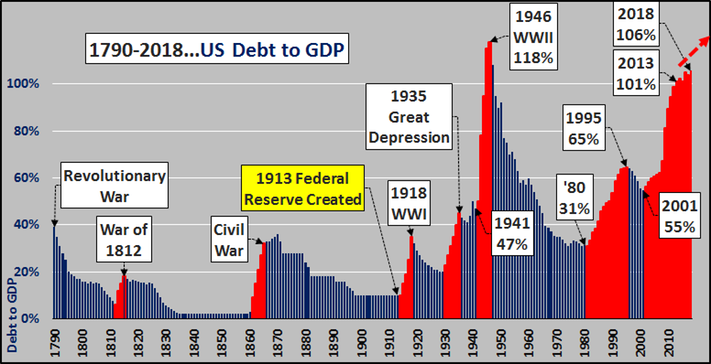VIDEO and ARTICLE
Chris Hamilton via Econimica blog,
America in the midst of the greatest crisis in its 242 years of existence. I say this based upon the US federal debt to GDP (gross domestic product) ratio. In the history of the US, at the onset of every war or crisis, a period of federal deficit spending ensued (red bars in graph below) to overcome the challenge but at the "challenges" end, a period of federal austerity ensued. Until now. No doubt the current financial crisis ended by 2013 (based on employment, asset values, etc.) but federal spending continues to significantly outpace tax revenues...resulting in a continually rising debt to GDP ratio. We are well past the point where we have typically began repairing the nation's balance sheet and maintaining the credibility of the currency. However, all indications from the CBO and current administration make it clear that debt to GDP will continue to rise. If the American economy were as strong as claimed, this is the time that federal deficit spending would cease alongside the Fed's interest rate hikes. Instead, surging deficit spending is taking place alongside interest rate hikes, another first for America.
The chart below takes America from 1790 to present. From 1776 to 2001, every period of deficit spending was followed by a period of "austerity" where-upon federal spending was constrained and economic activity flourished, repairing the damage done to the debt to GDP ratio and the credibility of the US currency. But since 2001, according to debt to GDP, the US has been in the longest ongoing crisis in the nation's history.

what is this crisis? The chart points out the debt to GDP surges in order to resolve the Revolutionary war, the Civil War, WWI, and WWII. But the debt to GDP surges since 1980 seem less clear cut. But simply put, America (and the world) grew up and matured, but the central banks and federal government could not accept this change. Instead, the CB's and Federal government wanted perpetual youth...growth without end. The chart below shows the debt to GDP ratio but this time against the decelerating growth of the total US population as a percentage (black line) but also against the faster decelerating growth of the 0-65yr/old population (yellow line).

Unfortunately, it gets so much worse. In 1968, the Johnson administration and Congress passed the Unified Budget to count (and spend) the excess tax receipts of Social Security and OASDI. In so doing, since 1968, the federal government has cumulatively spent (and goosed the economy) by $74 trillion to increase annual GDP to its current $20 trillion (chart below). This is $53 trillion in unfunded liabilities which should be there now, collecting interest to pay for future distributions. Instead, this money has already been spent and new debt must be issued if the obligations are to be honored.

If we count the federal debt plus unfunded liabilities (now beginning to come due) against GDP, we have a very unhappy picture. However, if we juxtapose federal debt and unfunded liabilities versus the annual growth of the total and 0-65yr/old population, a clear inverse relationship is shown (chart below). Using the Treasury data set, debt + unfunded liabilities (taken from the 2017 Treasury Bulletin) have risen to 380% of GDP and are set to eclipse the previous high seen in 2009 in short order. Fascinatingly, according to the Treasury, the advent of Obama-Care massively temporarily reduced the unfunded liabilities (shifting the liabilities off the Federal books)...but the temporary reprieve is over.

Put otherwise, the federal government has spent $74 trillion (at a progressively faster rate) over the past 50 years to artificially stimulate the US and world economy. But now the piper must be paid. There is no further OASDI surplus to be spent (or to buy US Treasury debt). All further deficit spending (and Treasury buying) must be funded from the domestic public (as it has been since 2015) so long as the Federal Reserve continues "normalizing" and so long as foreigners and the Intra-Governmental holdings continue to be net sellers.
The Social Security surplus is over and will turn to progressively larger outright deficits from here on. To maintain deficit spending, the federal government will need to run significantly larger deficits and issue significantly more US Treasury debt just to cover the OASDI deficits. This will mean significantly larger issuances of marketable debt while nearly all natural sources of Treasury buying have turned to net selling. The Fed's Treasury Holdings...Reviewing Operation Twist-Off or Who Will Buy Those Trillions of US Treasurys??? So, as the growth of the global economy grinds to a halt, banana republic mechanism are now whirring to avoid the truth of the matter becoming plain "Will The Real Global Economy Please Stand Up"
This is the crisis that will define the nation, the world, and determine the course of the world for at least the next century, if not further. As always, make of this what you will.